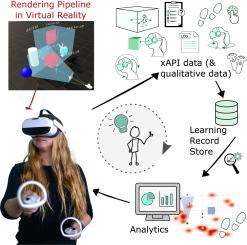Maximizing Learning: Evaluating the Effectiveness of VR/AR in Education
In recent years, Virtual Reality (VR) and Augmented Reality (AR) have emerged as transformative tools in the field of education. with rapid advances in technology and growing accessibility, educators and learners alike are tapping into the power of immersive experiences. But how effective are VR and AR in enhancing educational outcomes? In this extensive guide,we’ll delve deep into the benefits,challenges,best practices,and real-world case studies to evaluate the true potential of VR/AR in education.
What are VR and AR in Education?
Virtual Reality (VR) creates a fully immersive digital surroundings,allowing students to interact with content in ways that go far beyond conventional classroom methods. In contrast, Augmented Reality (AR) overlays digital information—such as images, sounds, or text—onto the real world, blending physical and digital learning experiences.
Integrating VR and AR technologies in curricula not only provides engaging and interactive learning environments but also bridges abstract concepts with tangible experiences. This opens up new avenues for teaching sciences, arts, history, languages, technical skills, and much more.
The Benefits of VR/AR in Education
Adopting VR/AR in the classroom has shown to significantly enhance the quality of teaching and learning. Here are some of the standout advantages:
- Enhanced Engagement: Immersive experiences capture students’ attention, making learning not just more enjoyable but also more effective.
- Improved Retention: interactive 3D simulations help students retain information through visualization and practice, supporting deeper understanding.
- practical Skill Growth: VR simulation labs enable learners to develop and practice skills in safe, controlled environments—vital for medicine, engineering, and other hands-on disciplines.
- Bridging Theory and Practice: AR facilitates direct connections between theory and real-world scenarios, enabling active experimentation and discovery.
- Accessibility and Inclusivity: Learners with disabilities can benefit from tailored VR/AR experiences, ensuring educational material is accessible to a wider audience.
- Global Collaboration: students from diffrent locations can interact in shared virtual spaces, fostering cross-cultural collaboration and understanding.
key statistics on VR/AR Effectiveness
- A PwC study found that VR learners completed training 4x faster than classroom learners and were 275% more confident in applying what they learned.
- According to the EdTechnica 2023 Report,77% of teachers believe that VR/AR increases student motivation.
- Research published in Computers & Education shows that AR can improve learning performance by up to 36% in K-12 settings.
Evaluating the Effectiveness of VR/AR in Education
While VR/AR clearly offers important potential, assessing its true effectiveness comes down to measuring learning outcomes, user satisfaction, and long-term skill retention.
Measuring Learning outcomes
- Pre- and Post-Assessment: Compare knowledge and skill levels before and after VR/AR-driven lessons.
- student Feedback: Collect insights via surveys and focus groups to gauge both enjoyment and educational value.
- Performance Metrics: Evaluate practical skills using standardized tests or challenges within the VR/AR environment.
- Longitudinal Studies: Assess long-term retention and submission of knowledge over time.
Challenges and Considerations
- Equipment Cost: Initial investment in VR/AR hardware and software can be high.
- Training Requirements: Instructors must be trained to effectively integrate VR/AR into lessons.
- Technical Issues: Connectivity,compatibility,and maintenance can hinder smooth deployment.
- Content Availability: High-quality, curriculum-aligned VR/AR learning modules are still being developed in many subjects.
Real-World Case studies: VR/AR Success Stories in Education
Stanford University’s Virtual Human Interaction lab
Stanford’s renowned lab uses VR to study human interaction and empathy. In one initiative, students “walk in the shoes” of others — such as refugees or individuals with disabilities — to foster empathy and social awareness. Results showed increased understanding and improved attitudes among participants.
Case Study: Medical Training with VR Simulation
Leading medical schools now utilize VR simulations for anatomy lessons and surgical practice. According to a study in the Journal of Medical Internet Research, students who trained with VR displayed better procedural knowledge and faster hand-eye coordination compared to peers using conventional methods.
AR in K-12 Classrooms: The Merge EDU Platform
Merge EDU brings interactive 3D learning to K-12 education. Students can explore the solar system, interact with virtual animals, and dissect digital frogs—without the mess or ethical concerns. Teachers report higher engagement and improved test scores in science modules.
Practical tips: Maximizing VR/AR Learning Effectiveness
- Start Small: Pilot VR/AR modules in a single class or subject before broader implementation.
- Align with Curriculum: Choose VR/AR content that directly supports learning objectives and standards.
- Ensure Accessibility: Select platforms and devices that cater to diverse needs and abilities.
- Train Educators: Provide hands-on workshops to help teachers feel confident with new technologies.
- Encourage Collaboration: Incorporate social features for peer interaction, discussion, and cooperative problem-solving.
- Collect Feedback: Continuously assess and refine experiences based on student input and outcome data.
First-Hand Experience: Educator & Student Testimonials
“When I introduced AR models into my biology class, students were genuinely excited to participate—they asked more questions and remembered details weeks later.”
— Dr. Angela Smith, High school Science Teacher
“Using VR in history lessons transported me to ancient Rome. It felt real! I understood architecture and daily life far better than from pictures alone.”
— Noah L., 9th Grade Student
Conclusion: The Future of VR/AR in Education
The journey to maximizing learning with VR/AR is only just beginning. Early evidence strongly supports the value of immersive technologies in fostering engagement, improving retention, and preparing learners for the complexities of the modern world. While challenges remain—particularly regarding cost and educator training—ongoing innovation and investment are rapidly unlocking new opportunities.
As VR/AR in education becomes increasingly mainstream, institutions that embrace these tools and evaluate their impact thoughtfully are poised to deliver richer educational experiences. By focusing on student outcomes, inclusivity, and practical integration, educators can truly revolutionize how knowledge is acquired and applied in the digital age.
Are you ready to explore the transformative power of VR/AR in your learning environment?

